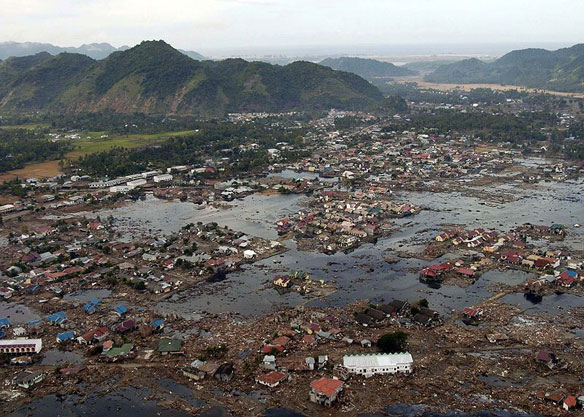
A village near the coast of Sumatra lays in ruin after the Tsunami that struck South East Asia. The death toll from the devastating 2004 Indonesia tsunami might have been lower had there been enough coastal vegetation to dull the blow, scientists suggest in a new study. Photo source: US Navy / Photographer Mate 2nd Class Philip A. McDaniel
Excerpts; By Our Amazing Planet
The death toll from the devastating 2004 Indonesia tsunami might have been lower had there been enough coastal vegetation to dull the blow, scientists suggest in a new study.
The study’s findings could help develop better strategies to protect areas susceptible to tsunamis, investigators said.
“The recent events in Japan and the February 2010 earthquake in Chile show that these threats continue to be real and require preparedness,” researcher Georg Cadisch, an agronomist at the University of Hohenheim in Stuttgart, Germany, told OurAmazingPlanet.
Past research suggested that coastal vegetation in the form of mangrove forests or rubber plantations could in principle serve as “bioshields” against tsunamis, blunting their impact by dissipating the energy of the onrushing killer waves, reducing flooding and thus human casualties and property damage. However, “many previous studies advocating bioshields have been criticized for lacking empirical evidence,” Cadisch said. “Unsubstantiated statements regarding protection provided by coastal vegetation can be obstructive and even dangerous, providing a false sense of security.”
To learn more, Cadisch and his colleagues developed computer models simulating the potential defensive effects of coastal vegetation against tsunami waves over a distance of 60 miles (100 kilometers) along the west coast of the Aceh region of the Indonesian island of Sumatra, the point of land closest to the epicenter of the deadly 2004 Indian Ocean earthquake. The models took into account factors such as coastal topography, wave height and tree width and height.
The models revealed that the distance of villages and dwellings from the shore was the most important factor in determining the extent of damage wrought by a tsunami. Still, they also revealed that coastal vegetation could shield communities, reducing casualties by an average of 5 percent. Coffee and cacao grown with shade trees reduced casualties by only 3 percent, while natural forests reduced casualties by 8 percent.
“For the first time, we were able to quantify the mitigation potential of coastal vegetation, particularly cultivated trees, on the impact of a very large tsunami,” Cadisch said…
Read Full Article, OurAmazingPlanet
Influence of coastal vegetation on the 2004 tsunami wave impact in west Aceh: Proceedings of the National Academy of Sciences
A Study By Juan Carlos Laso Bayasa, Carsten Marohna, Gerd Dercona,1, Sonya Dewib, Hans Peter Piephoc, Laxman Joshib, Meine van Noordwijkb, and Georg Cadischa,2, published in Proceedings of the National Academy of Sciences
Abstract: Coastal vegetation might have shrunk Indonesia’s tsunami death toll
A study estimates that the death toll of the devastating 2004 tsunami along Indonesia’s West Aceh coast would have been smaller had a forest shielded the coastal settlements from the shoreline. Previous studies have suggested that coastal vegetation can help blunt the impact of a tsunami by dissipating the energy of onrushing wave-trains, thus reducing flooding, property damage, and human casualties.
The lack of solid evidence for that suggestion prompted Georg Cadisch and colleagues to use a mathematical modeling approach to estimate the hypothetical effect of coastal vegetation on the destructive impact of tsunami waves over a distance of 100 km along the west coast of Aceh.
Although the authors’ models revealed that the distance between the shoreline and settlements was the most important factor in determining the extent of damage wrought by the tsunami, coastal vegetation, like trees or rubber plantations, shielding the settlements might have helped reduce casualties and property damage by 3-8%.
In addition, the authors propose that thick vegetation behind settlements likely led to a rise in casualties and destruction, possibly due to backwash containing debris from the initial waves – a fact corroborated by eyewitness accounts. The findings could help develop better strategies for risk management in areas susceptible to tsunamis, according to the authors.









